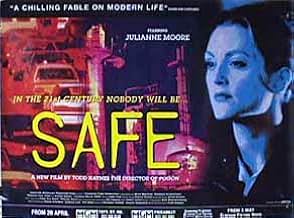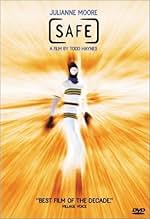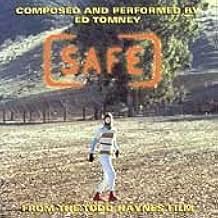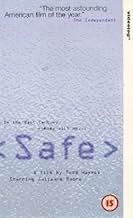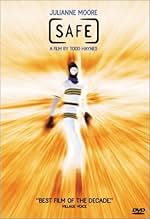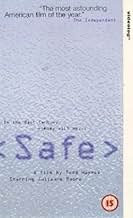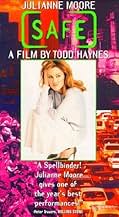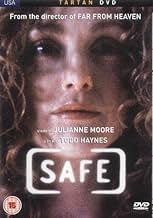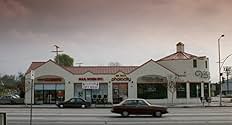VALUTAZIONE IMDb
7,1/10
18.638
LA TUA VALUTAZIONE
Una casalinga benestante e non eccezionale sviluppa una sensibilità chimica multipla.Una casalinga benestante e non eccezionale sviluppa una sensibilità chimica multipla.Una casalinga benestante e non eccezionale sviluppa una sensibilità chimica multipla.
- Regia
- Sceneggiatura
- Star
- Premi
- 4 vittorie e 13 candidature totali
Martha Velez
- Fulvia
- (as Martha Velez-Johnson)
Chauncey Leopardi
- Rory
- (as Chauncy Leopardi)
Allan Wasserman
- Client
- (as Alan Wasserman)
Jean St. James
- Client's Wife
- (as Jean Pflieger)
Recensioni in evidenza
Although it's been almost ten years since filmmaker Todd Haynes (Velvet Goldmine, Far From Heaven) made Safe, the film's only secured cinematic release in Australia in 2004. As Safe quietly satirises the 80s, the delayed release improves it, adding another layer of perspective to a heroine who lives life in a series of bubbles.
It's 1987, and timid California housewife Carol (a young Julianne Moore) is immersed in upper-middle class minutiae ensuring her couch is the right colour, sleepwalking through a tepid aerobics class, and submitting to her husband (Greg White from 24). But gradually cracks appear in this pristine life, tiredness, unexplained illness until she is diagnosed with multiple chemical sensitivity. She then moves to Wrenwood, a healing retreat founded by the charismatic Peter (Peter Friedman) but will this solve her problem? Or is it just another escape? Safe is a very interesting film about a woman so overwhelmed by her environment that she becomes allergic to it. Writer and director Haynes has combined aspects of the disease film (e.g. Love Story) with the psychological thriller as Carol doesn't know what triggers her symptoms, the audience never knows when she'll have another attack.
While Haymes criticises the New Age belief that illness is psychologically-based, in Carol's case, it's impossible to separate the psychological and physical aspects of her illness. The cinematography shows her dwarfed by her environment and Haymes offers no easy solutions. ***½/***** stars.
It's 1987, and timid California housewife Carol (a young Julianne Moore) is immersed in upper-middle class minutiae ensuring her couch is the right colour, sleepwalking through a tepid aerobics class, and submitting to her husband (Greg White from 24). But gradually cracks appear in this pristine life, tiredness, unexplained illness until she is diagnosed with multiple chemical sensitivity. She then moves to Wrenwood, a healing retreat founded by the charismatic Peter (Peter Friedman) but will this solve her problem? Or is it just another escape? Safe is a very interesting film about a woman so overwhelmed by her environment that she becomes allergic to it. Writer and director Haynes has combined aspects of the disease film (e.g. Love Story) with the psychological thriller as Carol doesn't know what triggers her symptoms, the audience never knows when she'll have another attack.
While Haymes criticises the New Age belief that illness is psychologically-based, in Carol's case, it's impossible to separate the psychological and physical aspects of her illness. The cinematography shows her dwarfed by her environment and Haymes offers no easy solutions. ***½/***** stars.
'Safe' is enigmatic, anxious, bewildering and captivating. It will divide viewers, but I argue that this is the hallmark of all true art. You will either love it or hate it, you will either get it or you won't. But it won't leave you indifferent.
Julianne Moore plays Carol White, the film's childlike protagonist with a phenomenal skill. In the hands of a more showy, ostentatious actress, Carol's 'illness' could have appeared trivial, her character, flighty, whiny and irritating. In the hands of Julianne Moore who is, in my opinion, the most intelligent, thoughtful and captivating actress working today, Carol's predicament is moving amd her character endearing. Her performance truly is astonishing. Never does she feel the need to overact, to emphasise Carol's confusion or her fear. She plays her with a childlike acceptance, a surface simplicity and a sing-songy girlish voice, and she is a master of restraint, implication, understatement. I have yet to see a more impressive performance from an actress whose skill lies in making it appear like she is doing very little, when really there is a huge amount going on underneath the surface. The film would be worth it for Julianne Moore alone, but it also has other things to reccommend it.
There's the excellent direction from the genius, Todd Haynes. His mainstream hit, the wonderful homage to Sirk 'Far From Heaven' catapulted Haynes into the mainstream, but I find this work even more affecting. Haynes is a genius at utilising the mise-en-scene for the maximum effect. He uses his camera as a painter would with colour - each shot is masterfully composed, with the director never allowing us to get too close to Julianne Moore's character, making her predicament all the more confusing and alienating. This is a film which demands thought and concentration, and what you take from it will depend upon individual disposition and experience.
The dialogue is generally sparse and quite functional, meaning that emphasis is placed onto the menacing soundtrack (giving the film a horror/thriller feel), the meticulously orchestrated mise-en-scene and, of course, the amazing nuances and depth of Julianne Moore's artistic gifts. In terms of what the film is trying to say, there is a real sense of satire in the second section of the film (When Carol goes to the commune to be 'cured') but there is no insistence upon one single message. This is reflected with a deeply ambiguous ending which leaves one feeling anxious and confused.
Overall, 'Safe' is a masterful piece of work. The team of Julianne Moore and Todd Haynes is (as we have seen with 'Far From Heaven') a match made ... in heaven. I would urge those who appreciate non maintream, thought provoking and unconventional films to give it try, just don't go in with 'Hollywood' expectations as you will be disappointed. Finally, I'd like to end by reiterating what is possibly the film's main strength - the presence of Julianne Moore. This truly is a captivating performance from her, and certainly one of the most astonishing I am likely ever to see. 'Safe' gives us the chance to watch this gifted actress in one of her most underrated, little seen, yet most remarkable roles.
Julianne Moore plays Carol White, the film's childlike protagonist with a phenomenal skill. In the hands of a more showy, ostentatious actress, Carol's 'illness' could have appeared trivial, her character, flighty, whiny and irritating. In the hands of Julianne Moore who is, in my opinion, the most intelligent, thoughtful and captivating actress working today, Carol's predicament is moving amd her character endearing. Her performance truly is astonishing. Never does she feel the need to overact, to emphasise Carol's confusion or her fear. She plays her with a childlike acceptance, a surface simplicity and a sing-songy girlish voice, and she is a master of restraint, implication, understatement. I have yet to see a more impressive performance from an actress whose skill lies in making it appear like she is doing very little, when really there is a huge amount going on underneath the surface. The film would be worth it for Julianne Moore alone, but it also has other things to reccommend it.
There's the excellent direction from the genius, Todd Haynes. His mainstream hit, the wonderful homage to Sirk 'Far From Heaven' catapulted Haynes into the mainstream, but I find this work even more affecting. Haynes is a genius at utilising the mise-en-scene for the maximum effect. He uses his camera as a painter would with colour - each shot is masterfully composed, with the director never allowing us to get too close to Julianne Moore's character, making her predicament all the more confusing and alienating. This is a film which demands thought and concentration, and what you take from it will depend upon individual disposition and experience.
The dialogue is generally sparse and quite functional, meaning that emphasis is placed onto the menacing soundtrack (giving the film a horror/thriller feel), the meticulously orchestrated mise-en-scene and, of course, the amazing nuances and depth of Julianne Moore's artistic gifts. In terms of what the film is trying to say, there is a real sense of satire in the second section of the film (When Carol goes to the commune to be 'cured') but there is no insistence upon one single message. This is reflected with a deeply ambiguous ending which leaves one feeling anxious and confused.
Overall, 'Safe' is a masterful piece of work. The team of Julianne Moore and Todd Haynes is (as we have seen with 'Far From Heaven') a match made ... in heaven. I would urge those who appreciate non maintream, thought provoking and unconventional films to give it try, just don't go in with 'Hollywood' expectations as you will be disappointed. Finally, I'd like to end by reiterating what is possibly the film's main strength - the presence of Julianne Moore. This truly is a captivating performance from her, and certainly one of the most astonishing I am likely ever to see. 'Safe' gives us the chance to watch this gifted actress in one of her most underrated, little seen, yet most remarkable roles.
Todd Haynes's modern melodrama, Safe (1995), has proven to be quite a controversial film for debate amongst film critics. Those who enjoyed the film defended it as an excellent critique on the twentieth century while others claimed it to be slow and boring. Although, as the study of film progresses Safe is being viewed under a differently light and becoming more accepted amongst American movie goers, developing what looks like the beginnings of a cult following. I would side with those who agree that the film is an excellent critique of the twentieth century although that is not my focus of analysis for this commentary.
The real focus of analysis involves one extremely short scene: where Carol White comes home and stares at the new furniture after it has been brought into the house a second time, which was about half way through the film. The mise-en-scene in this short five to ten second shot is extraordinary in its capture of the mood or in Carol White's case the sickness behind suburban life.
The new couch alone was the most powerful aspect of mise-en-scene. There it was, black in color, square in shape, perfectly spaced between the walls and lamps. The couch is empty and unused yet filling in space and suburban peace of mind. It is the focus of the entire shot, forcing the audience to stare on waiting for a reaction, some kind of acknowledgment from Carol White. The couch, to me, has essentially become a reflection of Carol White, fitting since her name is just as blank and lifeless as the couch.
I also thought the lighting of the room was crucial in creating the setting for the couch. The low key lighting of the enclosed room shuts out all life, helping to create that dead environment which Carol White cannot seem to escape. The darker scene really blurs the edges of the couch and the corners of the walls, forming a cave like design. This particular aspect of light really adds to the frighteningly scary mood which is most commonly felt and scene by audience members, but never really thought about or understood.
Sound and lack of it really set the tone for hidden narratives of suburban horror. The beginning of the short scene depicts Carol White walking in the darkened room to see the new couch, and only her light footsteps are heard. After this there is complete silence for at least five to ten seconds. Since the scene did not have any muffled background sounds I found it to be quite useful in describing the silence in which Carol White lives her life. Even the furniture is louder than she.
The style of mise-en-scene in this scene is quite evident throughout the rest of the film, and really shows its importance as a tool in every cinematic genre. A film such as Safe demands attention to detail and a unique style when it comes to mise-en-scene. One should always take the time to stop and enjoy the symbols, messages, and hidden narratives behind mise-en-scene.
The real focus of analysis involves one extremely short scene: where Carol White comes home and stares at the new furniture after it has been brought into the house a second time, which was about half way through the film. The mise-en-scene in this short five to ten second shot is extraordinary in its capture of the mood or in Carol White's case the sickness behind suburban life.
The new couch alone was the most powerful aspect of mise-en-scene. There it was, black in color, square in shape, perfectly spaced between the walls and lamps. The couch is empty and unused yet filling in space and suburban peace of mind. It is the focus of the entire shot, forcing the audience to stare on waiting for a reaction, some kind of acknowledgment from Carol White. The couch, to me, has essentially become a reflection of Carol White, fitting since her name is just as blank and lifeless as the couch.
I also thought the lighting of the room was crucial in creating the setting for the couch. The low key lighting of the enclosed room shuts out all life, helping to create that dead environment which Carol White cannot seem to escape. The darker scene really blurs the edges of the couch and the corners of the walls, forming a cave like design. This particular aspect of light really adds to the frighteningly scary mood which is most commonly felt and scene by audience members, but never really thought about or understood.
Sound and lack of it really set the tone for hidden narratives of suburban horror. The beginning of the short scene depicts Carol White walking in the darkened room to see the new couch, and only her light footsteps are heard. After this there is complete silence for at least five to ten seconds. Since the scene did not have any muffled background sounds I found it to be quite useful in describing the silence in which Carol White lives her life. Even the furniture is louder than she.
The style of mise-en-scene in this scene is quite evident throughout the rest of the film, and really shows its importance as a tool in every cinematic genre. A film such as Safe demands attention to detail and a unique style when it comes to mise-en-scene. One should always take the time to stop and enjoy the symbols, messages, and hidden narratives behind mise-en-scene.
This film is a remarkable exploration of the subtle yet terrifying ways in which everyday life can consume us. The standout performance from Julianne Moore as Carol White, a housewife who becomes increasingly allergic to her environment, serves as the perfect vessel to capture this eerie and disturbing sense of unease.
Moore's portrayal of Carol is a masterclass in understated acting. Throughout the film, she communicates a deep sense of fear and confusion through subtle physical gestures and inflections of her voice. One scene, in particular, where she breaks down in tears in her car, encapsulates the intensity of her performance.
The horror of the film, however, is not in jump scares or gore, but in the slow burn of Carol's deterioration. As her symptoms worsen, she becomes isolated from her family and friends, unable to find solace in her own home or the outside world. The mundanity of her suburban life becomes a metaphor for the very thing that's slowly destroying her.
The film's conclusion is ambiguous, leaving us uncertain as to whether Carol can ever truly escape from the grip of her isolation and illness. This open-endedness adds to the overall sense of unease, reinforcing the idea that we're constantly under threat from the everyday world around us.
Safe is a haunting film that terrifies through its quiet and understated approach. Julianne Moore's exceptional performance is central to this, but the masterful direction and cinematography make it a complete work of art. It's a must-see for anyone interested in exploring the ways in which modern life can corrode our mental and physical health.
Moore's portrayal of Carol is a masterclass in understated acting. Throughout the film, she communicates a deep sense of fear and confusion through subtle physical gestures and inflections of her voice. One scene, in particular, where she breaks down in tears in her car, encapsulates the intensity of her performance.
The horror of the film, however, is not in jump scares or gore, but in the slow burn of Carol's deterioration. As her symptoms worsen, she becomes isolated from her family and friends, unable to find solace in her own home or the outside world. The mundanity of her suburban life becomes a metaphor for the very thing that's slowly destroying her.
The film's conclusion is ambiguous, leaving us uncertain as to whether Carol can ever truly escape from the grip of her isolation and illness. This open-endedness adds to the overall sense of unease, reinforcing the idea that we're constantly under threat from the everyday world around us.
Safe is a haunting film that terrifies through its quiet and understated approach. Julianne Moore's exceptional performance is central to this, but the masterful direction and cinematography make it a complete work of art. It's a must-see for anyone interested in exploring the ways in which modern life can corrode our mental and physical health.
This truly is one of the rarest commodities in the cinema pantheon; a film that conveys multiple plot angles, each as disturbing as the next, yet in a most quiet and understated fashion. Watching the WASPish, vacant, and utterly clueless Carole (played by chameleon beyond compare Julianne Moore) slowly morph from armpiece San Fernando wife to a fragile shell of a person, may not be an experience you will enjoy at first, as a close friend of mine said after viewing "There's no damn way I'd pay eight bucks for that!". Just give it a day or two, for never has there been a film (at least not until The Blair Witch came along) that has a way of seeping into your subconscious as this. That same friend, who so soundly poo-pooed it, later confided to me that the final scenes, which show what Carole had become, were haunting him at work and rest. It is an interesting study in the effectiveness of true psychologically jarring film making, where much is left to the audiences imagination - including the root of this strange affliction, the viability of these help groups, and indeed Carole's perception of all that is happening to and around her.
The soundtrack is perfect - simple eery piano over looming synth. The use of the camera is as economical as it is effective - the less shown the more we think, with broad extreme long shots used primarily in the beginning, showing that Carole doesn't seem to belong in her own home. Yet this film's greatest triumph is, for all that she has been through, and the weak diseased person she became, Carole appears to find happiness and respect for herself. Without a second thought that is the most disturbing possibility I could, or would want to, imagine. Safe may very well be a film that does not lend itself to repeated viewing. But that's fine, because it only takes one dose of this quietly sad and ghostly film to haunt you ever
The soundtrack is perfect - simple eery piano over looming synth. The use of the camera is as economical as it is effective - the less shown the more we think, with broad extreme long shots used primarily in the beginning, showing that Carole doesn't seem to belong in her own home. Yet this film's greatest triumph is, for all that she has been through, and the weak diseased person she became, Carole appears to find happiness and respect for herself. Without a second thought that is the most disturbing possibility I could, or would want to, imagine. Safe may very well be a film that does not lend itself to repeated viewing. But that's fine, because it only takes one dose of this quietly sad and ghostly film to haunt you ever
Lo sapevi?
- QuizWhen it came time for Julianne Moore to record the director's commentary for the 2003 DVD release, this was the first time the lead actress had seen the movie in its entirety.
- BlooperAlthough this film was explicitly set in 1987, while Carol is driving on the highway, she passes a burgundy 1992 Cadillac de Ville.
- Citazioni
Carol White: [about her declining health] I'm sorry. I know it's not normal but I can't help it.
I più visti
Accedi per valutare e creare un elenco di titoli salvati per ottenere consigli personalizzati
- How long is Safe?Powered by Alexa
Dettagli
- Data di uscita
- Paesi di origine
- Lingue
- Celebre anche come
- A salvo
- Luoghi delle riprese
- Aziende produttrici
- Vedi altri crediti dell’azienda su IMDbPro
Botteghino
- Budget
- 1.000.000 USD (previsto)
- Lordo Stati Uniti e Canada
- 512.245 USD
- Fine settimana di apertura Stati Uniti e Canada
- 15.830 USD
- 25 giu 1995
- Lordo in tutto il mondo
- 512.558 USD
Contribuisci a questa pagina
Suggerisci una modifica o aggiungi i contenuti mancanti


